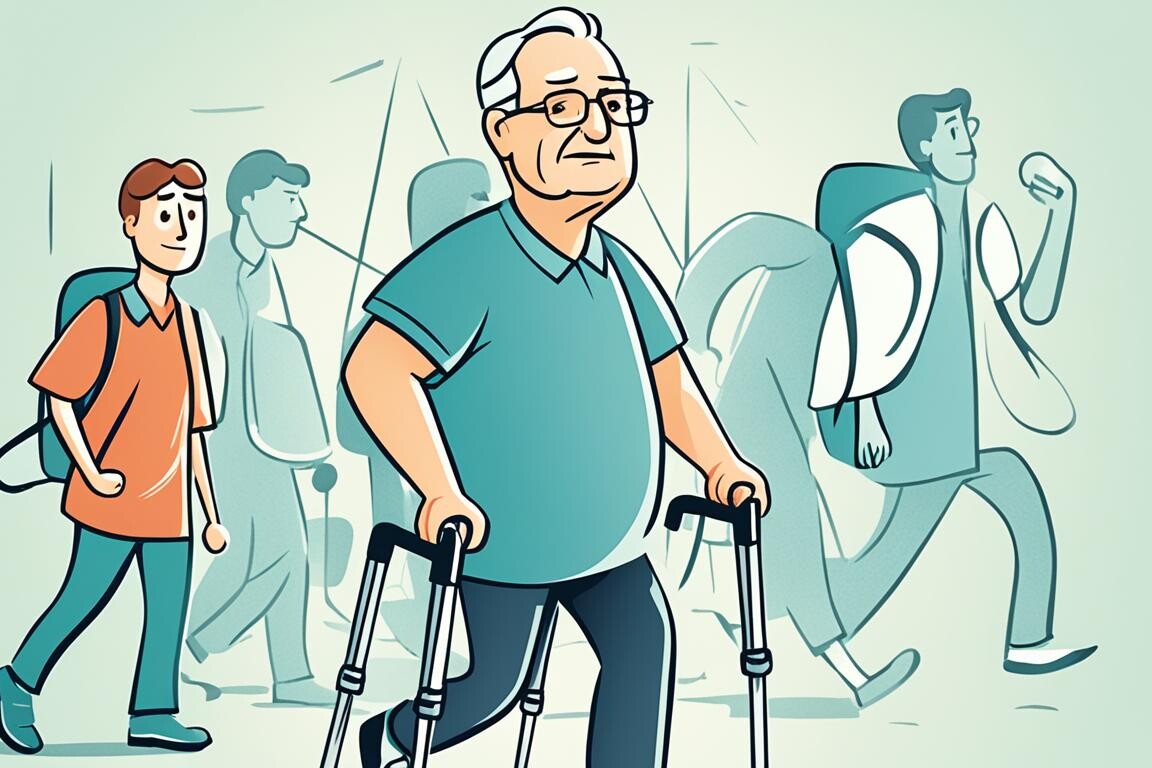Have you seen someone walk oddly, like dragging their toes or taking big steps? This shows they might have a gait disorder. A gait disorder means walking differently than usual. It could happen after an injury or because of a health problem. It really changes how someone lives.
Walking seems easy, but it’s super complex. It involves your nervous system, muscles, and heart and lungs all working together. If something goes wrong with any of these, a gait disorder might show up. These problems could be short-term or last a lifetime, needing regular care.
We’re going to talk about gait disorders, how common they are, and how they affect life. We’ll cover what causes them, the different types, and how doctors diagnose and treat them. You’ll finish knowing more about gait disorders and how to deal with them well.
Table of Contents
ToggleUnderstanding Gait Disorders
Definition and Prevalence
Gait disorders happen when someone walks differently than usual. They’re caused by problems with the body’s nervous, muscle, and breathing systems. These issues are often seen in older people.
Impact on Quality of Life
Gait disorders can really change someone’s life. They can lead to less freedom, falls, and getting hurt. Problems with balance and how we walk can make people more likely to fall. This is a big reason why the elderly can get hurt so badly. Sadly, these issues are not often found or treated early enough.
Causes of Gait Disorders
Gait disorders have many gait disorder causes, from issues in the brain to bone and muscle problems. Knowing these causes helps doctors diagnose and treat you better.
Neurological Conditions
Problems in the brain or nervous system can mess up your walking. For example, issues with feeling or moving can make you walk funny. Conditions like parkinsonism or balance difficulties can cause these problems.
Musculoskeletal Issues
Conditions that affect your bones and muscles can also be to blame. Things like arthritis or being born with the wrong body shape might change how a person walks. Seniors often have several reasons for their gait issues, such as bad balance, not seeing well, or problems in the brain that affect movement.
Medical Conditions
Many health problems can make your gait weird, too. Heart or lung issues and not enough blood getting to your legs can be culprits. Sometimes sudden problems walking can show there’s something bad happening in your brain or spine, a reaction to medicine, or a mental health condition.

Types of Gait Disorders
Healthcare pros often face different types of gait disorders. These include sensory ataxia, parkinsonism, and frontal gait disorder. Each has unique traits and causes.
Sensory Ataxia
Sensory ataxia comes from a problem in the proprioceptive system. This system tells us where our limbs are and how they move. People with this disorder may have trouble walking steadily. They often find it hard to keep balanced. This is because they can’t coordinate their body movements well. A few things can cause this, like damage to the nerves (peripheral neuropathy) or injuries to the spinal cord.
Parkinsonism
Parkinsonism makes a person walk in a specific way. They shuffle, stand bent over, and find it tough to start moving. This type of walking is common in Parkinson’s disease and other similar disorders. These illnesses hurt the brain, making it hard for the person to walk smoothly.
Frontal Gait Disorder
Frontal gait disorder is often linked to brain disorders like Alzheimer’s. People with this problem walk slowly, taking very small steps. They also find it hard to turn while walking. Their feet might feel like they’re stuck to the ground. This makes walking smoothly very hard for them.
Knowing these gait disorders helps doctors aim treatment better. They can help people with walking issues do better. This improves how they move, stay safe, and their life quality.
Gait disorder
A gait disorder affects the way someone walks. It can be due to many health issues. These problems change how we walk because of issues with our muscles, nerves, and hearts.
It’s important to know what causes different gait disorders. This helps doctors give the right treatment. Gait issues can make life hard, increasing the chance of falling. But with the right care, we can help people feel better and walk safer.

Diagnosing Gait Disorders
To start, doctors watch how a patient walks and ask about their health history. They look at how the patient stands and takes their first steps. They check step length, speed, how the arms move, and if the patient can do special walking tests. These steps are key to finding out more about gait disorders.
Clinical Observation
Healthcare professionals pay close attention to how a patient walks. They notice any unusual walk signs. This detailed look helps them understand if there are problems with the brain, body, or health causing the unusual walk.
Neurological and Orthopedic Examination
A detailed check of the nervous system and bones is also done. By learning about the patient’s history, they can plan these checks well. This step is important for deciding which gait disorders tests, like images or lab work, are needed.
Ancillary Diagnostic Tests
Based on what could be causing the problem, more tests might be needed. These could include brain images, nerve function tests, and lab checks. These tests give more details about the patient’s condition. They help the healthcare team make the best treatment plan.
Gait Disorder Treatment
The Gait disorder treatment works to fix the root problem. This could be from nerve, muscle, or other health issues. Patients might need drugs, therapy, or sometimes surgery to help.
Addressing Underlying Causes
If a gait disorder comes from a brain issue like Parkinson’s, medicines might help. Or, if it’s because of bad joints or a crooked spine, then physical or occupational therapy could be needed. For some, surgery might be the best option.
Physical and Occupational Therapy
Therapies are key in helping with gait disorders. They focus on making the body stronger, more balanced, and coordinated. They also teach how to use devices that make moving easier.
This helps people be more self-sufficient and enjoy life more.
Assistive Devices
Canes, walkers, or scooters all help by making moving safer and easier. The right one is chosen to match the person’s needs. This considers their balance, strength, and how bad their gait disorder is.

The Role of Cognition in Gait
Your cognition and gait work closely together. Executive function, visuospatial perception, and attention are vital for walking safely. When these cognitive skills are impaired, you might have issues walking. This can lead to more falls and other dangers.
Executive Function and Attention
Executive function and attention are crucial for a strong gait. Older adults with mild cognitive issues face a higher fall risk. This shows how important these skills are for safe walking. People with mild cognitive issues also often have trouble walking. It shows the tight link between cognition and gait.
Multitasking and Dual-Task Paradigms
Multitasking and dual-task paradigms help us understand this link better. People are asked to do mental tasks while walking. It’s interesting that older adults may fall more if they stop to talk. This shows how critical thinking is for walking safely. The ability to multitask keeps you balanced and mobile.
Conclusion
Gait disorders are complex and can really impact how you live. It’s key for healthcare folks to know about the different causes. They must also understand how thinking affects walking. This helps them treat and care for you better, improving your life.
Healthcare providers, by knowing the many causes of gait issues, can make care more personalized. They can combine ways to help, like focusing on how you think and move. The goal is to find the best ways to help you move better and do more on your own.
Managing gait disorders needs teamwork between you, your doctors, and using the best tools. Everyone working together can help you beat gait problems. This way, you can feel more sure moving around every day.
FAQ
What is a gait disorder?
Gait is how someone walks. An injury or a medical problem may change the way a person walks. This can include dragging toes, taking big steps, or feeling unsteady.
What causes gait disorders?
Gait disorders have many reasons. These include problems with the brain or nerves, issues with muscles and bones, and certain health problems. Things like not feeling where your body is (proprioception) or heart failure can change how someone walks.
What are the common types of gait disorders?
Popular gait issues are sensory ataxia, parkinsonism, and frontal gait disorder. Sensory ataxia comes from issues in feeling where your body is. Parkinsonism leads to a walk where you take small steps and lean forward. Frontal gait disorder is mostly seen in older people and those with certain brain diseases.
How are gait disorders diagnosed?
To find the cause of a gait disorder, doctors first watch how a person walks. They also ask about the person’s medical history and do certain tests. These can include watching the patient try different tasks. Sometimes, they also need to do more tests like brain scans.
How are gait disorders treated?
The focus of treating gait issues is to fix the main problem that’s causing the walk to change. This can involve taking medicines, doing physical or occupational therapy, or even having surgery. Therapies and devices like canes can make walking safer and easier.
How does cognition impact gait?
The mind’s job directly affects how we walk. Things like being able to plan, see space, and focus help us walk around safely. If these skills are not as good, a person might have trouble walking smoothly, even when just thinking while walking.
Source Links
- https://www.ncbi.nlm.nih.gov/pmc/articles/PMC5318488/
- https://www.movementdisorders.org/MDS/About/Movement-Disorder-Overviews/Gait-Disorders.htm
- https://www.sciencedirect.com/topics/neuroscience/gait-disorder
- https://www.webmd.com/brain/types-gait-disorders
- https://www.aafp.org/pubs/afp/issues/2010/0701/p61.html
- https://www.pacificneuroscienceinstitute.org/movement-disorders/conditions/gait-disorders/
- https://www.healthline.com/health/gait-and-balance-problems
- https://www.ncbi.nlm.nih.gov/pmc/articles/PMC3498517/
- https://www.ncbi.nlm.nih.gov/pmc/articles/PMC2922365/
- https://www.sciencedirect.com/science/article/abs/pii/S0002934317312950
About The Author

This article is medically reviewed by Dr. Chandril Chugh, Board-Certified Neurologist, providing expert insights and reliable health information.
Dr. Chandril Chugh is a U.S.-trained neurologist with over a decade of experience. Known for his compassionate care, he specializes in treating neurological conditions such as migraines, epilepsy, and Parkinson’s disease. Dr. Chugh is highly regarded for his patient-centered approach and dedication to providing personalized care.
→ Book a consultation to discover which remedies suit your needs best.




